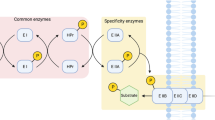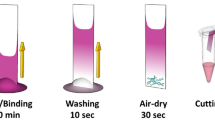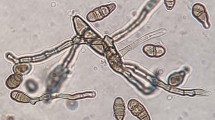Abstract
BAKER1 has described the isolation of dulcitol, a non-reducing sugar alcohol, from the exudate of the leaves of Euonymus japonica. An investigation of this exudate by partition chromatography on strips of filter paper, employing the usual solvents for sugar analysis, revealed that dulcitol gives rise to a discrete dark brown spot on the paper chromatogram when it is sprayed with an ammoniacal solution of silver nitrate and heated. Other polyhydric alcohols, such as mannitol, sorbitol, glycerol and ethylene glycol, also reduce ammoniacal silver nitrate under these conditions, a most surprising and unpredictable result. In view of the importance of partition chromatography for the analysis of intimate mixtures of the reducing sugars2, an examination of the properties of the polyhydric alcohols on the paper chromatogram was necessary in order to avoid any confusion between these closely related substances. It is of interest to note that Partridge3 has encountered inositol, a cyclic hexitol, along with glucose and fructose in an extract of the fœtal blood of sheep, since he found that it also gives rise to a discrete brown spot on the paper chromatogram with the ammoniacal silver nitrate reagent.
This is a preview of subscription content, access via your institution
Access options
Subscribe to this journal
Receive 51 print issues and online access
$199.00 per year
only $3.90 per issue
Buy this article
- Purchase on SpringerLink
- Instant access to full article PDF
Prices may be subject to local taxes which are calculated during checkout
Similar content being viewed by others
References
Baker, W., Nature, [164, 1093 (1949)].
Hirst, E. L., and Jones, J. K. N., Farad. Soc., General Discussion on Chromatographic Analysis (September 1949).
Partridge, S. M., Biochem. J., 42, 238 (1948).
Partridge, S. M., Nature, 164, 443 (1949).
Lew, B. W., Wolfrom, M. L., and Goepp, R. M., J. Amer. Chem. Soc., 68, 1449 (1946).
Georges, L. W., Bower, R. S., and Wolfrom, M. L., J. Amer. Chem. Soc., 68, 2169 (1946).
Hough, L., Jones, J. K. N., and Wadman, W. H., Nature, 162, 448 (1948); J. Chem. Soc., 2511 (1949).
Jackson, E. L., “Organic Reactions”, 2, 341 (New York : John Wiley and Sons, 1944).
Hirst, E. L., and Jones, J. K. N., J. Chem. Soc., 1659 (1949).
Author information
Authors and Affiliations
Rights and permissions
About this article
Cite this article
HOUGH, L. Application of Paper Partition Chromatography to the Separation of the Polyhydric Alcohols. Nature 165, 400 (1950). https://doi.org/10.1038/165400a0
Issue date:
DOI: https://doi.org/10.1038/165400a0
This article is cited by
-
Chromatographic separation of polyhydric alcohols on resins of the KU-2 type. Communication 1. Development of a quantitative method of analysis
Bulletin of the Academy of Sciences, USSR Division of Chemical Science (1966)
-
Separation of mannitol, sorbitol and dulcitol by paper chromatography
Folia Microbiologica (1966)
-
Acid-Soluble Nucleotides of Staphylococcus Aureus: Massive Accumulation of a Derivative of Cytidine Diphosphate in the Presence of Penicillin
Nature (1961)
-
Der Kohlenhydrathaushalt eines Schimmelpilzes (Phycomyces blakesleeanus) in Abh�ngigkeit von den Kulturbedingungen
Archiv f�r Mikrobiologie (1959)
-
Characterization of 2-Amino-2-Deoxy-D-Altrose
Nature (1957)



